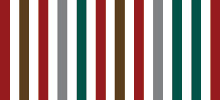=
Brug
Auto's daveren
over de brug
maar de kreek
voert uit het bos
nieuwe stilten aan
-- Eddy Pinas
Bridge
Vehicles thunder
over the bridge
but the creek
brings new silences
from the forest
-- trans. Marieke Visser
Marieke Visser: The idea is clear: the fact that a bridge can bring worlds together is not necessarily a blessing. It should not be taken lightly.
The bridge over the Suriname River is to me also a strong reminder of the May demonstrations in 1999, when many of us went out on the streets to protest the presidency of Jules Wijdenbosch. He was the one who built this visible bridge, this symbol of hope, of growth, of expansion. We shouted: "We don't want bread with bridge!" But after a few days everything went back to normal. And now, now and then, I notice thoughts in my own head like: "Well, at least he built something tangible for the country!"
Chandra van Binnendijk: I am intrigued by this little poem. Not only because of its simple beauty, but because the poet refers to "silences", indicating there is more than just one silence. The creek supplies us with new silences, he says--and I wonder: Are these more of the same, or do we get a variety, will we get different kinds of silences each time the creek brings them to us?
When playing around with these questions, my image of the bridge changed, it widened the scope of how we could look at a bridge. It is not just a construction which links one bank of a river to the other, but it also has something above it--air--and something underneath it--water or ground. The water brings new silences, but the water itself has many layers--there are the bubbles and the waves on the surface, but there are also the undercurrents. The same goes for the air above the bridge. So looking at a bridge in a wider sense we could see it as one (horizontal) layer of many in its wider surroundings. What does one see when looking at the surroundings while standing on the bridge?
MV: I think of a friend, the visual artist René Tosari, the man behind Waka Tjopu. More than anyone I know, he is at home in both worlds: the artists in the diaspora and the artists at "home", but also the worlds of the older generation and the younger generation. I don't see him as a bridge builder or a bridge--it is more like that he is a person on the bridge, accepted by both worlds as someone who "belongs" to their world.
When I think about this image, a man standing on the bridge, walking to both sides, sharing with people on both sides, I see how this is how I myself feel. That is also why the Wakaman Project was so exciting. It transcends that issue of home or away, of that recurring--and sometimes very irritating and time-consuming--question of which world we belong to. I don't want to choose, I am not willing to defend one world over another. But I do speak both languages, and I do miscommunicate in both languages as well. On both ends of the bridge are sources of inspiration, which I feel free to be inspired by.
I have the feeling that more people are moving in that direction, and I see how the bridge can be a way to get out of a place that has become too limited, and maybe later on it is a means to return with new stuff in your suitcase. But also the bridge itself means a new freedom--it is like an opened window (to the future but also to the past). It is an opportunity to connect and to re-connect and to cut loose (disconnect) as well.
Untitled (1998), by René Tosari; photo by Roy Tjin
Conversation: bridges and silences
Tuesday, July 14, 2009
at 8:51 PM
Labels: conversation, pinas, poem, tosari, van binnendijk, visser
Subscribe to:
Post Comments (Atom)







0 comments:
Post a Comment